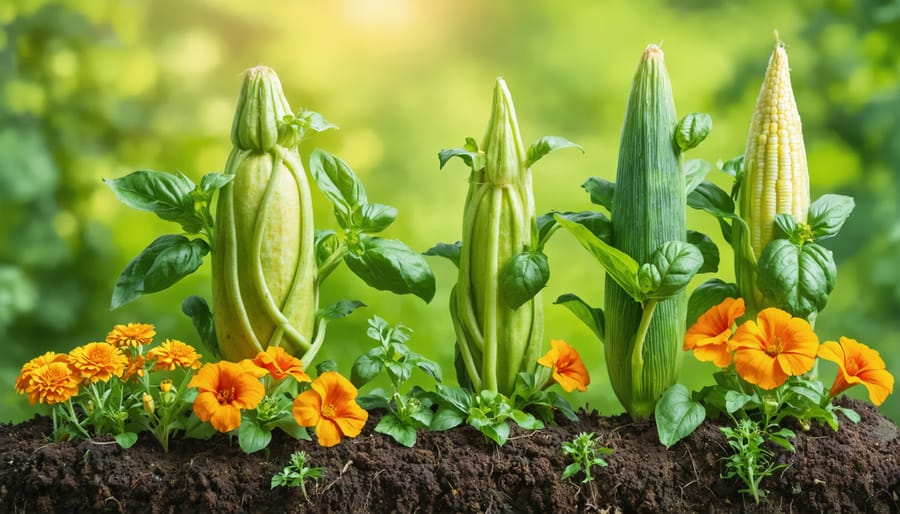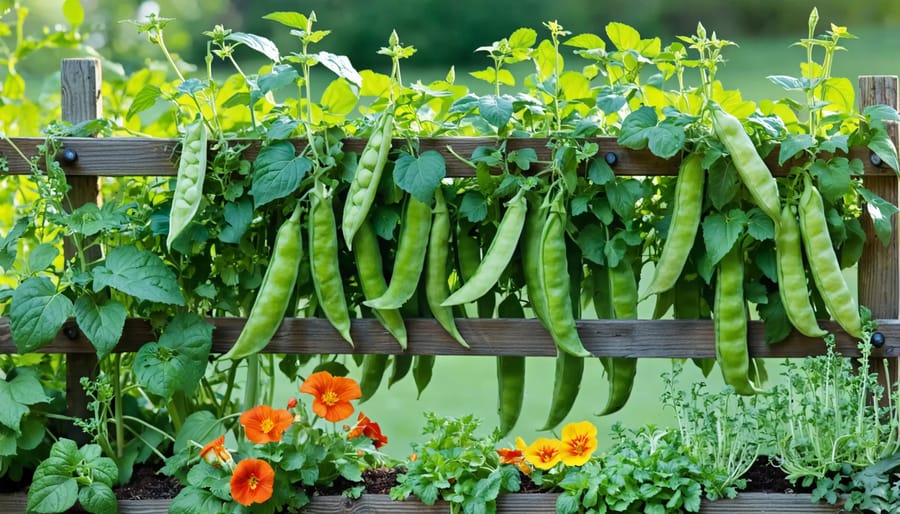Transform your spaghetti squash garden into a thriving ecosystem by planting aromatic herbs like basil and oregano alongside your vines – these companions naturally repel squash bugs and cucumber beetles while attracting beneficial pollinators. Plant bush beans and radishes between squash mounds to maximize vertical space and naturally fix nitrogen in the soil, boosting overall garden productivity. Create natural shade partnerships by growing heat-sensitive lettuce and spinach beneath the sprawling squash leaves during summer months, protecting delicate greens while utilizing every inch of garden space. Position tall, sturdy corn stalks on the north side of your squash patch, providing natural trellising support for vines while creating a windbreak that protects tender squash leaves from damage. This strategic companion planting approach not only maximizes your growing space but also creates a balanced garden ecosystem that naturally controls pests, improves soil health, and increases yields without chemical interventions.
Why Companion Plant with Spaghetti Squash?
Spaghetti squash, while rewarding to grow, comes with its own set of challenges that companion planting can help address. These sprawling vines need plenty of space, are heavy feeders, and can be susceptible to certain pests and diseases. That’s where strategic companion planting becomes your garden’s secret weapon.
By choosing the right plant partners, you can maximize your growing space while naturally protecting your squash from common threats. For instance, tall, sturdy plants can serve as natural trellises, while shallow-rooted companions make efficient use of the soil around your squash vines. Some companions even help improve soil fertility, which is crucial for these nutrient-hungry plants.
Pest management is another significant benefit of companion planting with spaghetti squash. Certain flowers and herbs naturally repel problematic insects like squash bugs and cucumber beetles, while others attract beneficial pollinators essential for fruit development. Marigolds, for example, help deter nematodes in the soil, while nasturtiums can act as trap crops for aphids.
Additionally, companion planting can improve the overall health of your garden ecosystem. Some plants help break up compacted soil with their root systems, while others provide natural shade that helps retain soil moisture – particularly beneficial during hot summer months when spaghetti squash is actively growing.
Best Companion Plants for Spaghetti Squash
Herbs That Enhance Growth
Several aromatic herbs make excellent companions for spaghetti squash, offering both protection and flavor enhancement to your garden. Basil is a standout partner, naturally repelling common squash pests while attracting beneficial pollinators. Plant a few basil plants around the perimeter of your squash patch to create a fragrant protective barrier.
Oregano serves as another fantastic companion, with its strong scent helping to deter harmful insects. As a low-growing herb, it also acts as a living mulch, keeping the soil cool and retaining moisture. Consider planting oregano near the base of your squash plants, where it can spread naturally.
Mint, while beneficial, should be planted with caution. Its pest-repelling properties are valuable, but mint can quickly take over a garden bed. To harness its benefits without the risk, grow mint in contained areas or buried pots near your squash. The aromatic oils from these herbs not only protect your plants but can also enhance the flavor of your squash when harvested together.
For best results, intersperse these herbs throughout your squash patch, creating a diverse and fragrant garden that supports healthy growth while deterring unwanted visitors.
Vegetable Companions
Spaghetti squash thrives when planted alongside several complementary vegetables that enhance its growth and help maximize garden space. One of the most successful combinations is the traditional Three Sisters gardening method, where corn provides natural support for the climbing vines while beans fix nitrogen in the soil.
Peas make excellent companions, as they also improve soil fertility and don’t compete for nutrients. Radishes are particularly helpful when planted nearby, as they deter common squash pests and mature quickly before the squash vines spread. Bush beans work well along the edges of your squash patch, while lettuce can thrive in the partial shade created by mature squash leaves.
Consider planting aromatic herbs like oregano and mint nearby to confuse and repel squash bugs and beetles naturally. Just remember to give your spaghetti squash plenty of room to spread, as the vines can extend 6 feet or more. These thoughtful pairings not only maximize your garden space but also create a naturally balanced growing environment that promotes healthy, abundant harvests.

Flowering Friends
Brighten up your spaghetti squash patch with these colorful natural pest-repelling companions! Marigolds are absolute champions in the garden, producing a natural chemical that deters harmful nematodes and other underground pests. Plant these cheerful orange and yellow blooms around the perimeter of your squash patch for both protection and beauty. Nasturtiums serve double duty as well – their bright flowers are not only edible but also act as trap plants, attracting aphids away from your precious squash vines. These climbing beauties can be planted between squash hills, adding splashes of color while maximizing your growing space. Consider adding borage too; its blue star-shaped flowers attract beneficial pollinators that’ll help boost your squash yields.
Space-Saving Planting Strategies
Vertical Growing Solutions
Growing spaghetti squash vertically is an excellent space-saving solution that works wonderfully with companion planting strategies. By training your squash vines upward on sturdy trellises, cattle panels, or arbors, you create valuable ground space for beneficial companion plants while improving air circulation around your squash.
When growing vertically, install your support structure before planting, ensuring it’s at least 6 feet tall and firmly anchored. Plant your spaghetti squash at the base, spacing plants about 2 feet apart. As the vines grow, gently weave them through the trellis or secure them with soft plant ties.
Low-growing companions like basil, oregano, and marigolds can thrive in the space beneath your vertical squash. These plants help maximize your garden’s efficiency while providing pest control and improved pollination. For extra support, plant pole beans alongside your squash – they’ll naturally climb the same structure while fixing nitrogen in the soil.
Remember to support developing squash fruits with mesh bags or old pantyhose slings as they grow. This prevents them from breaking off the vine under their own weight. The vertical growing method also makes harvesting easier and keeps fruits clean and off the ground, reducing the risk of rot.

Intercropping Techniques
Maximizing garden space with spaghetti squash requires thoughtful intercropping strategies, as these sprawling vines need room to grow. One effective technique is to plant tall, narrow crops like corn or sunflowers along the north side of your squash bed, creating natural supports while utilizing vertical space. These taller plants won’t shade your squash when properly positioned.
Between squash vines, consider adding quick-growing crops like radishes, lettuce, or bush beans. These plants will mature before the squash vines spread too far, giving you an early harvest while making the most of available space. Herbs like basil and oregano can be tucked into gaps, adding both flavor to your kitchen and natural pest protection to your garden.
For efficient space usage, try the “three sisters” method: plant corn first, then sow squash around the base once corn reaches 6 inches tall, and add pole beans when corn is knee-high. The beans will climb the corn while the squash spreads below, creating a harmonious growing system.
Remember to leave enough walking paths between plantings for easy harvest and maintenance. A good rule of thumb is to maintain 2-foot-wide access strips between vine areas.

Plants to Avoid
While spaghetti squash is generally a friendly garden companion, there are certain plants you’ll want to keep at a distance to ensure the best growing conditions for your vines. Most notably, other members of the cucurbit family, such as pumpkins, cucumbers, and watermelons, should be planted well away from your spaghetti squash. These plants not only compete for the same nutrients but also can cross-pollinate, potentially affecting fruit quality and seed viability.
Potatoes are another plant to avoid placing near your spaghetti squash. These heavy feeders compete for similar nutrients and can attract pests that might harm your squash plants. Similarly, avoid planting near sweet potatoes, as they can outcompete your squash vines for space and resources.
Brassicas like broccoli, cabbage, and cauliflower aren’t ideal companions either. These plants have different soil needs and can inhibit squash growth through root competition. Additionally, their large leaves may cast too much shade on your developing squash vines.
Keep fennel at a distance from your spaghetti squash patch. This herb is known to inhibit the growth of many garden plants, including squash, through allelopathy – releasing chemicals that can stunt the growth of neighboring plants.
Lastly, while sunflowers are beautiful additions to any garden, they shouldn’t be planted too close to your spaghetti squash. These tall beauties can cast excessive shade and their deep roots compete aggressively for water and nutrients, potentially limiting your squash harvest.
By keeping these plants separate from your spaghetti squash, you’ll create optimal growing conditions for a bountiful harvest.
Companion planting with spaghetti squash is not just a gardening technique – it’s a journey toward creating a more vibrant, productive, and sustainable garden ecosystem. By carefully selecting companion plants like beans, marigolds, nasturtiums, and herbs, you can naturally deter pests, improve soil health, and maximize your growing space. Remember that successful companion planting requires thoughtful planning and observation, but the rewards are well worth the effort.
Whether you’re working with a small backyard plot or an extensive garden, these plant partnerships can significantly boost your spaghetti squash harvest while creating a more diverse and beautiful growing space. Don’t be afraid to experiment with different combinations and learn from your experiences. Start small by introducing one or two companion plants this growing season, and gradually expand your garden’s diversity as you become more comfortable with the practice.
With proper planning and care, your spaghetti squash and its companions will thrive together, providing you with bountiful harvests and the satisfaction of working in harmony with nature’s own pest control and fertilization systems. Happy planting!




